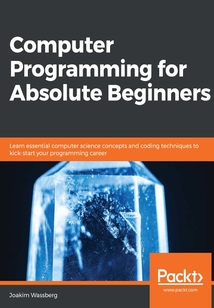舉報 

會員
Computer Programming for Absolute Beginners
Learninghowtocodehasmanyadvantages,andgainingtherightprogrammingskillscanhaveamassiveimpactonwhatyoucandowithyourcurrentskillsetandthewayyouadvanceinyourcareer.Thisbookwillbeyourguidetolearningcomputerprogrammingeasily,helpingyouovercomethedifficultiesinunderstandingthemajorconstructsinanymainstreamprogramminglanguage.ComputerProgrammingforAbsoluteBeginnersstartsbytakingyouthroughthebuildingblocksofanyprogramminglanguagewiththoroughexplanationsandrelevantexamplesinpseudocode.You'llunderstandtherelationshipbetweencomputerprogramsandprogramminglanguagesandhowcodeisexecutedonthecomputer.Thebookthenfocusesonthedifferenttypesofapplicationsthatyoucancreatewithyourprogrammingknowledge.You'lldelveintoprogrammingconstructs,learningallaboutstatements,operators,variables,anddatatypes.Asyouadvance,you'llseehowtocontroltheflowofyourprogramsusingcontrolstructuresandreuseyourcodeusingfunctions.Finally,you'llexplorebestpracticesthatwillhelpyouwritecodelikeapro.Bytheendofthisbook,you'llbepreparedtolearnanyprogramminglanguageandtakecontrolofyourcareerbyaddingcodingtoyourskillset.
目錄(103章)
倒序
- 封面
- 版權信息
- Why subscribe?
- Contributors About the author
- About the reviewer
- Packt is searching for authors like you
- Preface
- Section 1: Introduction to Computer Programs and Computer Programming
- Chapter 1: Introduction to Computer Programs
- A brief history of computing
- A brief history of programming
- What is a program?
- Understanding the binary system
- Summary
- Chapter 2: Introduction to Programming Languages
- Why do we have programming languages?
- How programming languages have evolved?
- The family tree of programming languages
- Translating code into something that the computer understands
- Syntax and the building blocks of a programming language
- Summary
- Chapter 3: Types of Applications
- Standalone applications
- Client-server applications
- Web applications
- Mobile applications
- Distributed applications
- Cloud-based applications
- Other types of applications
- Summary
- Chapter 4: Software Projects and How We Organize Our Code
- Code modules
- Working with software projects
- Working with packages to share code
- Avoiding conflicts using namespaces
- Summary
- Section 2: Constructs of a Programming Language
- Chapter 5: Sequence – The Basic Building Block of a Computer Program
- The importance of sequences
- Summary
- Chapter 6: Working with Data – Variables
- Declaring and initializing variables
- Primitive data types
- Composite type
- Summary
- Chapter 7: Program Control Structures
- Controlling the execution path
- Selection with the if statement
- Selection with the switch statement
- Iteration with the for loop
- Iteration with the while loop
- Iteration with the do while loop
- Iterating over sequences using for each
- Summary
- Chapter 8: Understanding Functions
- Deciding what goes into a function
- Writing a function
- Returning values from a function
- Function arguments
- Functions in action
- Local and global variables
- Summary
- Chapter 9: When Things Go Wrong – Bugs and Exceptions
- Understanding software bugs
- Understanding types of software bugs
- Finding bugs using a debugger
- Handling exceptions
- Summary
- Chapter 10: Programming Paradigms
- Understanding structured programming
- Understanding object-orientated programming
- Understanding functional programming
- Understanding logic programming
- Other paradigms
- Multi-paradigm languages
- Summary
- Chapter 11: Programming Tools and Methodologies
- Understanding version control systems
- Unit testing
- Integration testing
- Other types of tests
- Software releases
- Understanding software deployment
- Software development process methodologies
- Summary
- Section 3: Best Practices for Writing High-Quality Code
- Chapter 12: Code Quality
- Defining code quality
- Writing code with readability in mind
- Writing code with efficiency in mind
- Is smart code smart?
- Code quality – best practices
- Summary
- Appendix A: How to Translate the Pseudocode into Real Code
- The pseudocode examples
- C++
- C#
- Java
- JavaScript
- PHP
- Python
- Appendix B: Dictionary
- Other Books You May Enjoy 更新時間:2021-06-11 18:38:53
推薦閱讀
- 數據庫基礎教程(SQL Server平臺)
- 同步:秩序如何從混沌中涌現
- ETL數據整合與處理(Kettle)
- SQL Server入門經典
- Java Data Science Cookbook
- 正則表達式必知必會
- MySQL基礎教程
- 數據庫應用基礎教程(Visual FoxPro 9.0)
- Python醫學數據分析入門
- 數據庫原理與應用
- 探索新型智庫發展之路:藍迪國際智庫報告·2015(上冊)
- 智慧的云計算
- MySQL數據庫技術與應用
- 數據挖掘競賽實戰:方法與案例
- The Natural Language Processing Workshop
- PostgreSQL高可用實戰
- Oracle 11g數據庫管理員指南
- Oracle 內核技術揭密
- Flume日志收集與MapReduce模式
- 大學計算機:理解和運用計算思維
- SQL必知必會(第5版)
- SQL Server從入門到精通(第5版)
- 實用計算機基礎
- 七周七數據庫
- Android Studio 3.6 Development Essentials(Kotlin Edition)
- 云邊協同大數據技術與應用
- 實用數據分析
- DM8數據中心解決方案:達夢實時同步工具
- 大數據預處理技術
- Ethereum Projects for Beginners

